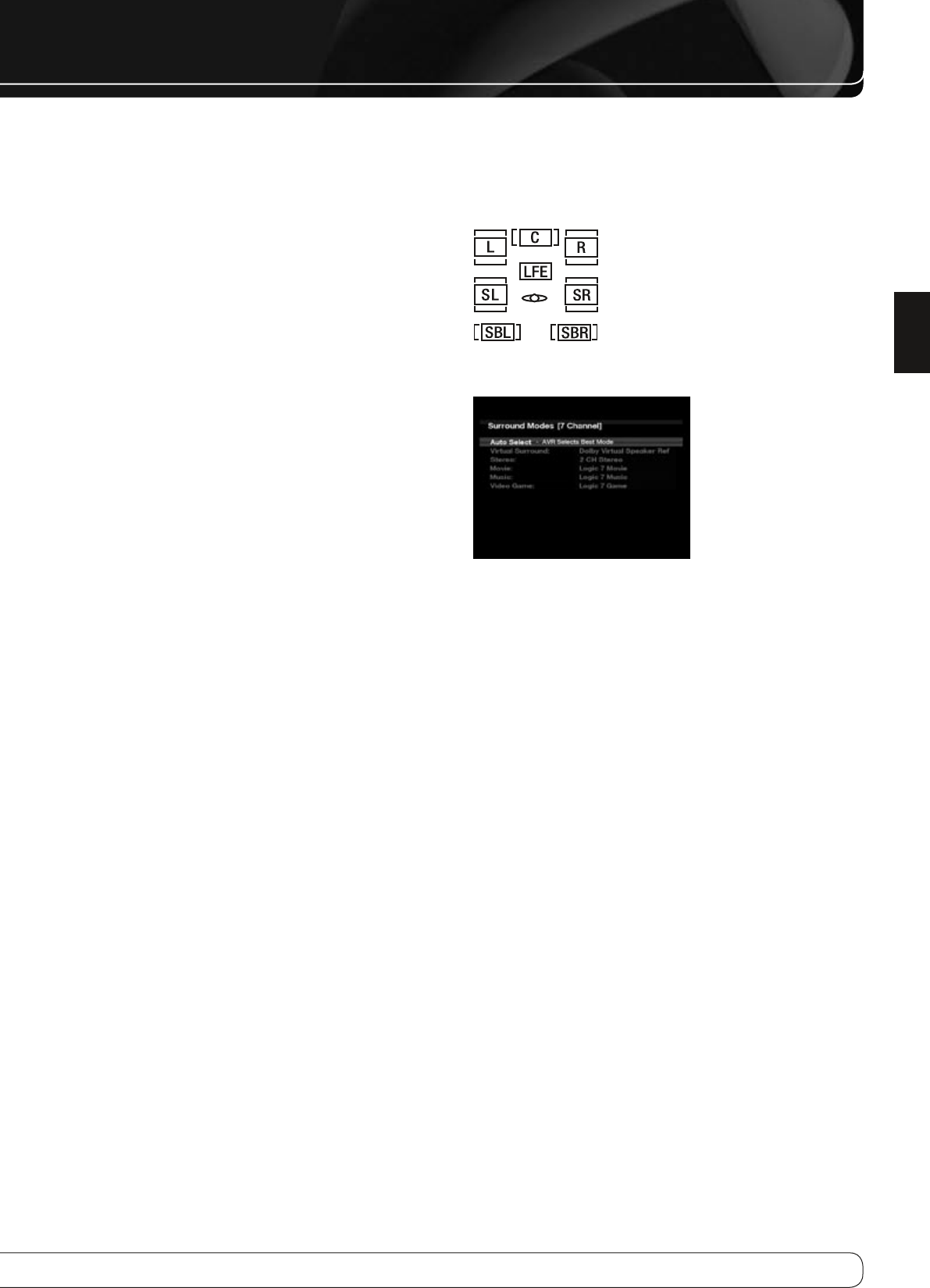
31
ENGLISH
OPERATION
The first number indicates the number of front channels in the signal:
“1” represents a monophonic recording, usually an older program that has
been digitally remastered or, more rarely, a modern program for which
the director has chosen a special effect.
“2” indicates the presence of the left and right channels, but no center
channel.
“3” indicates that all three front channels (left, right and center) are present.
The second number indicates whether any surround channels are present:
“0” indicates that no surround information is present.
“1” indicates that a matrixed surround signal is present.
“2” indicates discrete left and right surround channels.
“3” is used with DTS-ES bitstreams to represent the presence of the discrete
surround back channel in addition to the side surround left and right
channels.
“4” is used with 7.1-channel digital formats, including Dolby TrueHD, Dolby
Digital Plus, DTS-HD and DTS-HD Master Audio, to indicate the presence
of two discrete side surround channels and two discrete back surround
channels.
The third number is used for the LFE channel:
“0” indicates no LFE channel.
“.1” indicates that an LFE channel is present.
The 6.1-channel signals – Dolby Digital EX and DTS-ES Matrix and Discrete –
each include a flag meant to signal the receiver to decode the surround back
channel.
For Dolby Digital EX materials, the incoming bitstream will be displayed as
3/2/.1 EX-ON. For older discs, the display may show EX-OFF, but you will still
be able to select the Dolby Digital EX mode manually.
For DTS-ES materials, the incoming bitstream will be displayed as 3/3/.1
ES-ON.
When a PCM signal is received, the PCM message, followed by the sampling
rate of the signal (32kHz, 44.1kHz, 48kHz or 96kHz), will appear in the front-
panel display.
In addition, the Speaker/Channel Input Indicators will indicate the number
of channels discretely encoded in the signal by displaying a letter inside
that channel’s speaker box. A line will connect the SBL and SBR boxes when
a 6.1-channel signal is detected, indicating that the same signal is playing
through both speakers. The letters flash when no signal is present, such as
when a DVD is paused.
Speaker/Channel Input Indicators
When only two channels – left and right – are present, the analog surround
modes may be used to decode the signal into the remaining channels.
Figure 14 – Surround Modes
If you would prefer a different surround format than the native signal’s digital
encoding, press the Surround Modes Button to display the Surround Modes
menu (see Figure 14).
The Auto Select option (the first line) uses the native signal’s digital encoding,
e.g. Dolby Digital or DTS. For two-channel materials, the AVR defaults to Logic
7 Movie mode. If you prefer a different surround processing mode, select the
appropriate line from the menu: Virtual Surround, Stereo, Movie, Music or
Video Game.
Each line is set to a default surround mode:
Virtual Surround
• : Dolby Virtual Speaker Reference
Stereo
• : 7-channel stereo
Movie
• : Logic 7 Movie
Music
• : Logic 7 Music
Video Game
• : Logic 7 Game
You may change each line’s setting to a different surround mode. The choice
of new modes depends on the number of speakers in your system.
Virtual Surround
• : Dolby Virtual Speaker Reference or Wide
Stereo
• : 2-channel stereo, 5-channel stereo or 7-channel stereo
Movie
• : Logic 7 Movie, DTS Neo 6:Cinema, Dolby Pro Logic II Movie, Dolby
Pro Logic IIx Movie
Music
• : Logic 7 Music, DTS Neo 6:Music, Dolby Pro Logic II Music, Dolby
Pro Logic IIx Music
Video Game
• : Logic 7 Game, Dolby Pro Logic II Game, Dolby Pro Logic
IIx Game


















